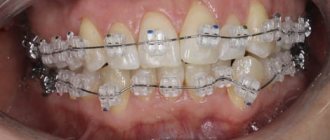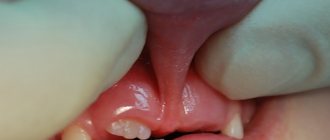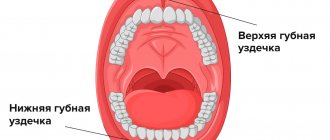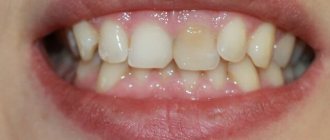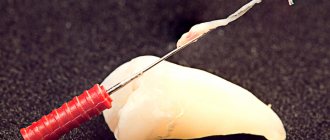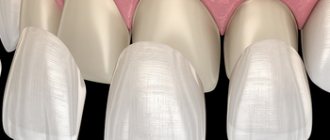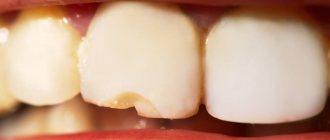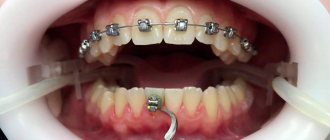What is it and why do we need it?
Such anatomical formations are the thinnest folds of the mucous membrane that connect the mobile lips and tongue with the fixed parts of the oral cavity: the gums and the sublingual space.
In total, there are three frenulums in the baby’s mouth:
- Tongue - located under the tongue.
- Upper lip - localized between the upper lip and the gum mucosa above the level of the central incisors.
- Lower lip - connects the inner surface of the lower lip with the gums at the level of the middle of the alveolar process on the lower jaw.
Despite their small size, such mucous folds are of great importance in human life. In a newborn, they are responsible for proper attachment to the mother's nipple. In older children, the frenulum is involved in the correct pronunciation of sounds and in the formation of a normal bite.
Contraindications for surgery
If there is a frenulum defect, the dentist or speech therapist will advise the most optimal period for the operation.
It depends on the age of the child, the presence of teeth and their health, malocclusion, as well as speech problems.
Correction of defects of the hyoid frenulum has a number of limitations and contraindications, including:
- cancer;
- hematological diseases;
- infections;
- inflammatory processes in the body;
- untreated teeth and inflammation in the mouth.
Short frenulum and why it is dangerous
Shortening of the frenulum is understood as a decrease in its absolute length or its incorrect location, which makes it relatively short (i.e., the length remains normal, but its incorrect localization causes all the symptoms characteristic of shortening).
A short frenulum of the upper or lower lip in a baby can negatively affect the process of breastfeeding. In this case, the child cannot correctly position the nipple in the oral cavity and create a sufficient vacuum necessary for sucking and swallowing. Therefore, in order to get enough, the baby has to make significant efforts. The baby quickly gets tired and stops breastfeeding without being properly satisfied. Such children behave restlessly, require frequent breastfeeding, but do not gain weight well.
In children over 3 years old, a shortened upper frenulum can cause an increase in the interdental spaces between the upper incisors and their advancement sharply anteriorly. A short lower labial frenulum sometimes causes malocclusion.
Also, a decrease in size or incorrect location of any of them can have an extremely negative impact on speech function. Children 2 years of age who have not had this pathology diagnosed or corrected in time often do not pronounce individual sounds. Such speech defects are difficult to correct.
Operation methods
There are two methods of performing the frenulum trimming operation: classic - using a scalpel or scissors, and modern, more expensive - using a laser.
Both methods are effective and have their own characteristics, but there is practically no difference in the results. Depending on the complexity of the defect, the age of the baby, his character and condition, doctors advise choosing one or another cutting method.
Scalpel
Surgery using a scalpel is slightly painful, causes discomfort, and also requires a special postoperative rehabilitation period. Its features:
- The duration of the operation to cut the hyoid frenulum for children using a scalpel is at least 20 - 30 minutes.
- The doctor performs all procedures using local anesthesia.
- In the oral cavity, a small incision is made on the frenulum with a scalpel, depending on the width, thickness and length of the frenulum.
- The wound is sutured using special absorbable threads.
- Trimming with a scalpel is accompanied by mild bleeding, possible swelling, discomfort and pain in the postoperative period.
- The scar heals within a week and then goes away.
On the first day after surgery, it is important to maintain speech rest. During the rehabilitation period, you should limit your intake of solid foods.
For speedy healing, it is recommended to rinse your mouth with special healing and antibacterial solutions.
We will talk about methods of treating pulpitis of primary teeth in children and advise ways to eliminate it. And here we have provided a photo and description of the problems associated with red spots in a child’s mouth.
By going to the following address: https://dentist-pro.ru/detskaya-stomatologiya/d-zuby/karies/butylochnyj.html - you will learn how to treat bottle caries.
Laser
A more modern way to eliminate the defect of the hyoid frenulum is the use of a laser. This method has a number of features and advantages:
- Laser cutting of the frenulum of the tongue is painless and lasts only 10 - 15 minutes.
- Special dental products (gels or sprays) are used as anesthesia; they are applied to and around the frenulum.
- The dentist makes an incision with a modern laser, which instantly seals the edges of the incision, eliminating the occurrence of bleeding.
- Thanks to the rapid sealing of the wound, there is no need for stitches.
- Healing of the incision site occurs quickly, within a period of no more than two days, so long-term wound care is not required.
- Elimination of frenulum defects using a laser is easier to tolerate for patients and significantly reduces the risks of complications in operations of varying degrees of complexity.
Laser surgery for children is less painful. We will learn how it is carried out in the following video:
If you prepare your baby in advance, he will definitely feel like a brave hero when he is put on protective glasses and undergoes a quick procedure.
How to check a child's frenulum?
A shortened frenulum between the lip and gum is diagnosed quite simply even in infants. To do this, you need to carefully pull back the child’s lips and see how pronounced the fold of the mucous membrane is and where it is attached. If it is short, then it will have a thick appearance and its attachment point will be at the very base of the incisors.
The hyoid frenulum normally has a length of at least 8 mm and is attached approximately halfway between the root and tip of the tongue. A small frenulum usually looks like a fold on the mucous membrane, attached along its entire length to the tongue or sublingual space.
Recommendations after surgery
In the postoperative period, it is important to follow the instructions and recommendations of the attending physician . This will help avoid painful inflammatory processes, damage to sutures and contribute to the patient’s speedy recovery.
Doctors' advice after surgery usually concerns oral hygiene, nutrition and diet, as well as auxiliary procedures (gymnastics and exercises with a speech therapist).
Basic recommendations and tips:
- In the first few hours after the procedure, you should not eat or disturb the sore spot, examine or touch the stitches.
- Two hours after the operation is completed, it is allowed to eat soft food: soups, cereals, water. It is important to limit solid and mucosal irritating foods (sour, spicy, salty).
- The rehabilitation period after surgery with sutures lasts about a week; during this time you cannot talk much so that the sutures do not come apart.
- Every day after eating, you need to clean your teeth and mouth, regularly rinse your mouth with decoctions of chamomile, sage or oak bark, and also use antiseptic medicinal solutions.
- In addition, lubricate the wound itself with medications as prescribed by the doctor (solcoseryl ointment, sea buckthorn oil, etc.).
- As prescribed by the treating dentist and speech therapist, it is necessary to perform preventive exercises to avoid impaired diction, as well as to develop the muscles of the tongue.
What to do if the child does not eat
Due to oral discomfort, pain or stress during the postoperative period, the baby will refuse to eat.
The sucking reflex can cause discomfort and anxiety. Therefore, babies should try feeding soft (liquid) food from a syringe or from a spoon.
For older children, the best way to prepare food is to puree it in a blender.
What to do if pain occurs
If a child experiences pain after surgery under local anesthesia, the doctor will prescribe painkillers.
For the first few days, minor discomfort and pain are quite normal due to the stitches. It is important to remain calm, not allow the child to talk and distract him with games from unpleasant thoughts.
What to do if inflammation or pus appears
A white coating may appear in the baby’s mouth after surgery; this is a normal reaction of the body.
This is a natural process for the formation of new mucous membrane. Thorough rinsing with antiseptic solutions will help deal with plaque. You can try rinsing your mouth with regular furatsilin.
If the doctor's instructions are not followed, redness, pus, and increased pain may appear, which requires consultation with your doctor.
What to do if your temperature rises
When immediately after surgery the baby has a high temperature, you need to give him an antipyretic.
Temperature is a common reaction of the body during postoperative treatment. But if it persists for more than a day, or even more so for several days, you need to contact your doctor. A prolonged fever may indicate an infection.
How to stretch
It is necessary to immediately make a reservation that, due to anatomical features, only the frenulum under the tongue can be stretched without surgery. This technique is usually taught by a speech therapist and is effective only if all recommendations are carefully followed over the course of several months.
Before performing any exercises, it is recommended to do a special massage to stretch the soft tissues. To do this, you need to carefully take your tongue by the very tip and with gentle movements move it upward, then to the sides and pull it forward a little. Gentle stroking from bottom to top along the frenulum using the thumb and index finger has a good effect.
The exercises themselves are performed sequentially twice a day:
- Relax your tongue as much as possible and place it on your lower lip. Hold for 10 seconds in 3 sets.
- Stick your tongue out of your mouth as far as possible. Fix in this position for 10 seconds. Repeat 3 times.
- Extend your tongue and circle your lips with it.
- Click your tongue for 10 seconds, imitating the clatter of horse hooves.
- Open your mouth wide. Slowly run the tip of your tongue across the roof of your mouth, moving from your teeth to your throat.
- Place your tongue on the roof of your mouth just behind your teeth. Holding it in this position, open your mouth as wide as possible.
Such fairly simple exercises help both stretch the frenulum on the tongue and correct some speech defects.
Speech therapy exercises
Speech therapists offer a wide range of exercises that are aimed at stretching the frenulum of the tongue. All exercises are carried out in a playful way, which only increases the baby’s interest in the exercises.
- The first and quite common exercise is the “horse”. To do this, the baby needs to make clicking movements, imitating the sound of a horse.
- For small children, you can offer the “kitten” exercise - give the baby a saucer and ask him to lick it. Instead of a saucer, the child can be offered any other object, for example, a spoon.
- For older children, you can use more conscious games, for example, ask the child to imagine that the oral cavity is a room in which the ceiling needs to be painted, the tongue is used as a paint roller, and the ceiling is the sky.
Stretching the frenulum can occur not only with exercises that are aimed at stretching the frenulum in length; exercises that are aimed at stretching the frenulum to the side give excellent results. For example, ask the child to count the teeth in the mouth, or “paint” the inside of the cheeks with paint.
The basis of all exercises, one way or another, is stretching the frenulum in the literal sense of the word.
The number of exercises will depend on the clinical picture, the length of the frenulum in the cavity and, of course, on the age of the child. Volunteer professor Bessonov Sergey Nikolaevich CONSTANTA Clinic through the eyes of a child! Anesthesia for operations in children Treatment of children with the support of the Charitable Foundation
Surgical correction
If a short frenulum is detected in the maternity hospital, then its trimming is carried out immediately. This is done so that the baby can properly take the nipple and eat properly. If shortening is diagnosed at an older age and is not corrected by speech therapy techniques, then three options for surgical treatment are possible:
- Frenotomy is cutting to increase its length.
- Frenectomy is a circumcision when it is almost completely excised.
- Frenuloplasty is a plastic surgery during which the place of its attachment in the mouth is changed.
Despite the fact that frenulum surgery itself is quite common, most parents have a lot of questions about this procedure. We will consider the main ones below.
Why trim?
A too small size of such a fold of the mucous membrane can cause difficulty sucking at the breast in infants, and problems with the pronunciation of certain sounds and with the arrangement of teeth in the permanent dentition in older children. To avoid such problems, pruning is required.
Do I need to prune?
Most doctors, including the famous Dr. Komarovsky, are of the opinion that a short frenulum should be trimmed if it adversely affects the child’s ability to suck milk or pronounce certain sounds.
When a short frenulum does not negatively affect the processes of sound production and bite formation, then in such cases surgical intervention is not required.
What kind of doctor cuts?
Typically, frenulum correction operations are the responsibility of a dentist.
At what age is it best to have surgery?
When the frenulum should be trimmed is decided individually for each child. If we are talking about a fold on the upper lip, then correction is done no earlier than 6 years. Typically, the operation is performed only after the eruption of the permanent upper incisors. If correction is required on the lower lip, this is done more often after the 4th year of life.
In most cases, the hyoid frenulum is cut before 1 year of age (most often this is done in the maternity hospital). But correction is possible at any age.
How do they prune?
The frenulum trimming operation is performed on an outpatient basis in the surgical office of a dental clinic. The doctor carefully stretches the fold of the mucous membrane and makes a small incision with a sharp scalpel. After that, small sutures made of threads are applied to the edges, which after some time dissolve on their own and do not need to be removed.
A more modern technique is laser dissection, which eliminates the need for stitches, which speeds up the child’s recovery process.
Does it hurt to prune?
The dissection procedure is performed under local anesthesia, which eliminates the possibility of any pain.
«
Preparing for surgery
Trimming the frenulum is a fairly simple operation that does not require special preparatory measures. Most often, the following procedures need to be performed before surgery:
- prepare a general blood test;
- check the blood for clotting (the so-called hemosyndrome test);
- do fluorography.
Carrying out an operation in infancy is easier for a child to tolerate due to the fact that he does not understand and does not remember what is happening around him.
At the age of one year, surgery is quite stressful for a baby, so it is very important to prepare him for this procedure in advance.
This requires psychological support from parents, encouragement and an explanation of the importance of the moment. To prevent your child from being capricious, you can take his favorite toys or a tablet with cartoons with him.
It is very important to ensure that the child is fed before the procedure, since after it you cannot eat for two hours.
What to do if a child breaks the frenulum
Children at any age are quite active and mobile. Therefore, injuries are inevitable. Quite often, parents turn to the dentist with the following problem: the baby fell unsuccessfully and tore the frenulum above the upper lip or under the tongue. At the same time, damage to the lower lip is extremely rare due to the fact that normally it is almost not expressed.
If a child cuts the frenulum, then the following signs will be characteristic of such an injury:
- Swelling of the soft tissues in the mouth and above the lip (if the child has torn the upper lip).
- Quite profuse bleeding.
- Pain in the mouth when talking or eating.
In any case, if the baby has torn the mucous fold under the upper lip or under the tongue, you should immediately consult a doctor. It is he who will decide whether such a gap needs to be sutured and will carry out the necessary procedures. Self-treatment can lead to negative consequences: the tissues will not heal properly with the formation of rough scars, which will subsequently lead to an incorrect bite and unclear pronunciation of sounds.
Reasons for incorrect formation
Most often, a short frenulum of the tongue in children occurs if one of the parents or relatives had the same problem, that is, due to a hereditary factor and genetic predisposition.
At the same time, boys are more inclined to adopt this defect. The non-hereditary appearance of a short frenulum depends on the negative influence of unfavorable factors on the fetus in the first trimester of its development.
Reasons for this feature may include:
- difficulties and pathologies during pregnancy (diseases or infections);
- chronic diseases of the mother or childbirth after 35 years;
- poor environmental situation in the place of residence;
- abdominal injuries;
- exposure to harmful drugs and substances (paints, varnishes, etc.);
- exposure to drugs and antibiotics.
Consequences of a short frenulum of the upper lip
Defects in the structure of the frenulum of the upper lip entail a number of negative consequences:
- During the neonatal period or in infancy, the child may have problems with sucking. In such cases, plastic surgery is performed as early as possible to restore breastfeeding.
- A shortened frenulum makes it difficult to pronounce certain words and impairs diction. Many speech therapists recommend frenuloplasty to correct the pronunciation of sounds in children.
- Impaired chewing due to a short frenulum can lead to problems with the digestive system.
- A short frenulum stretches the mucous membrane of the gums, which over time leads to the appearance of an interdental gap - a diastema, which is a cosmetic defect and can lead to malocclusion.
- Due to the retraction of the gums, a gum pocket appears in which plaque and tartar accumulate, which contributes to the development of caries and other inflammatory processes.
- A wide frenulum is a cosmetic defect and also contributes to excessive accumulation of plaque.
- Improper fastening of the bridle in some cases leads to increased sensitivity of the teeth.
Frenum trimming surgery is also an important part of preventing periodontal disease.
